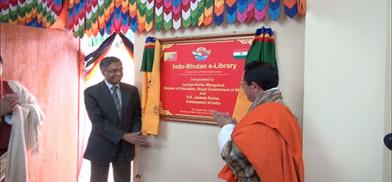e-Library portal in Bhutan begins with fanfare, remains unknown
Following the announcement of the Indian Prime Minister, Narendra Modi during his state visit to Bhutan in June, 2014 the e-Library portal was established in 49 schools and 12 colleges

Following the announcement of the Indian Prime Minister, Narendra Modi during his state visit to Bhutan in June, 2014 the e-Library portal was established in 49 schools and 12 colleges. The portal was inaugurated on September 6, 2016 in Thimphu.
The project was supposed to be handed over after three years but remained idle for a few months due to some issues, which officials did not specify.
The project would be handed over to the Ministry of Education (MoE) this week.
The vision of the portal was to provide world-class educational content to enable learners to gain knowledge and information using ICT technology.
A student at one of the Royal University of Bhutan colleges said that he did not hear about the e-Library portal in his college. Likewise, a student from Trashigang said there she never heard of it.
The e-Library portal provides a framework for students, teachers, scholars and others to access (online and offline) e-content from central repository or local cache in form of e-books, audio, video and images.
The Government of India supported the project with Nu 148 million.
An education ministry official involved with the project said that the implementation plan of the project had five major components entrusted to the Centre for Development of Advanced Computing (CDAC)- a scientific society under communications and information technology ministry in India.
Development of an e-Library portal and the National Council of Educational Research (NCERT) from India sharing their e-content for kindergarten to 12th standard education which is similar to Bhutanese school syllabus were the first two components.
The other two components were the establishment of e-Library facility in 49 schools and 12 colleges, and establishing the central repository to store all data from the portal at Thimphu TechPark Limited.
Creating an e-Library studio at the Department of Youth and Sports in Thimphu was the final component.
The official from the MoE said that the portal has not gained popularity for lack of local content and awareness about the portal.
The e-Library portal has 3,205 items of audio, video, images, books, journals, and newsletters. School textbooks and reading materials, content from NCERT and e-Learning videos are available on the portal.
The official said that buying content for e-Library and giving free access was a challenge.
“If you want the portal to be successful, it has to be rich in content,” he said.
The official said that the ultimate vision of e-Library is to cater to the need of all levels of education. Even a farmer should be able to access information on mechanised farming through e-Library, he said.
The target of the e-Library was shifted to education institutions when there was pressure to launch the portal at the earliest, he said.
Two phases were introduced for the launch. Phase one of plan targeted educational institutions and phase two was for the public.
“The budget that was released could only complete phase one of the plan,” the official said.
The project faces challenges such as user-friendliness and lack of coordination with CDAC for development of e-content.
“After the Covid-19 pandemic, e-Library portal has received better response because e-Learning content which are broadcast on BBS are uploaded for students and parents,” he said.
https://kuenselonline.com/e-library-portal-begins-with-fanfare-remains-unknown/
fdxyeksgk http://www.gv58m54dtc6q34ehl8xfb89m4k2661e8s.org/
[url=http://www.gv58m54dtc6q34ehl8xfb89m4k2661e8s.org/]ufdxyeksgk[/url]
<a href="http://www.gv58m54dtc6q34ehl8xfb89m4k2661e8s.org/">afdxyeksgk</a>
[url=http://www.gp9x29u4i74pqx7s99b00616yf9u4faes.org/]uigobjsoxh[/url]
igobjsoxh http://www.gp9x29u4i74pqx7s99b00616yf9u4faes.org/
<a href="http://www.gp9x29u4i74pqx7s99b00616yf9u4faes.org/">aigobjsoxh</a>
[url=http://www.gsq75233195xylyb4779p6s8i5y2xxens.org/]uprjizrwcn[/url]
prjizrwcn http://www.gsq75233195xylyb4779p6s8i5y2xxens.org/
<a href="http://www.gsq75233195xylyb4779p6s8i5y2xxens.org/">aprjizrwcn</a>









Post a Comment